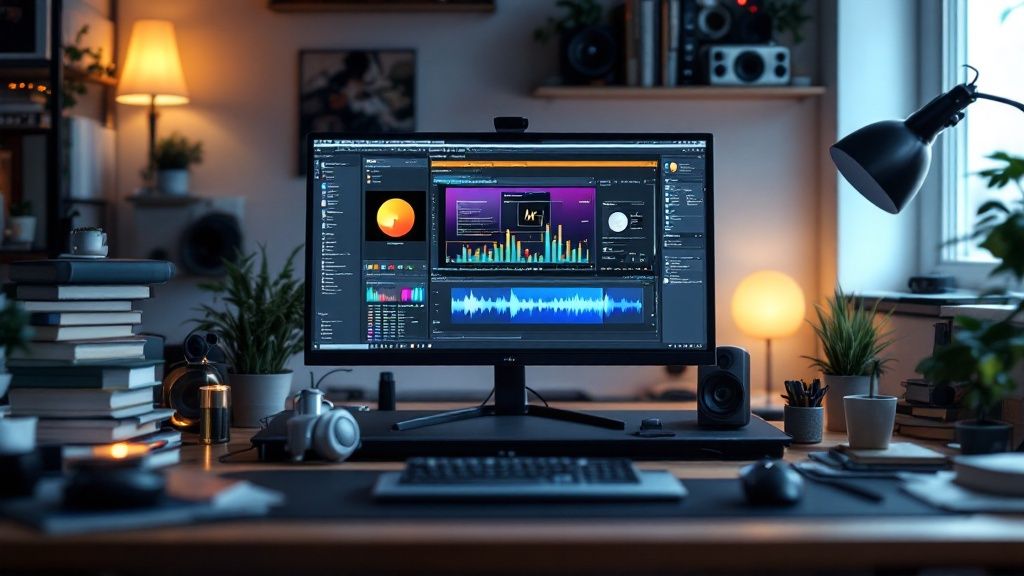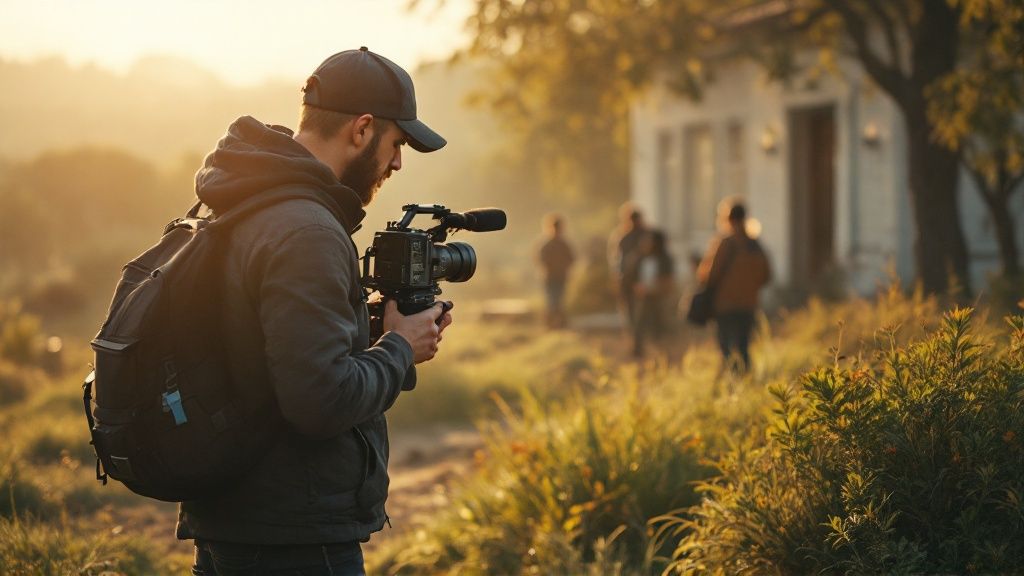
8 Personal Brand Videos Strategies To Level Up Your Content
Building a Powerful Personal Brand Through Video
Video has become the most effective way for business leaders to connect with their audiences and build real credibility. As a CTO, CEO, founder, or entrepreneur, your ability to communicate authentically through video can help you attract investors, recruit top talent, and win loyal customers.
Over the past decade, video has evolved from basic webcam recordings into a core tool for personal brand building. Modern leaders use video content to share their expertise, demonstrate their vision, and develop genuine connections with viewers around the world.
However, success with video requires more than just pointing a camera and talking. You need a strategic approach that considers your audience, messaging, and on-camera presence. The most impactful video content combines clear communication principles with an understanding of what resonates with your specific viewers.
This article outlines 8 proven video strategies to strengthen your personal brand and establish yourself as a leader in your field. You'll learn practical techniques for creating compelling content that builds trust and delivers real value to your audience.
1. Storytelling-Driven Content

Building a strong personal brand means going beyond polished presentations to create real connections with your audience. Storytelling-driven video content lets you share authentic experiences and lessons learned, helping forge emotional bonds with viewers. For business leaders and entrepreneurs, this approach makes your brand more relatable and builds genuine trust.
The power of storytelling comes from its classic narrative structure – much like a mini-documentary about your journey. Take inspiration from content creators like Casey Neistat who shares his daily entrepreneurial life, Gary Vaynerchuk who offers candid business insights, and Peter McKinnon who brings viewers into his creative process. Their success shows how being real and vulnerable helps create lasting audience connections.
Features of Storytelling-Driven Content:
- Personal Narrative Structure: Clear beginning, middle, and end with a defined story arc
- Emotional Connection Emphasis: Focus on resonating with viewers over pure information
- Character Development: Show the human side with personality and values
- Story Arc Implementation: Build rising action, climax, and resolution
Pros:
- Creates Strong Emotional Bonds: Human stories lead to deeper viewer engagement
- Highly Memorable and Shareable: Compelling narratives spread naturally
- Builds Authentic Connections: Personal experiences create genuine trust
- Differentiates from Competitors: Real stories stand out from standard corporate content
Cons:
- Time-Consuming to Produce: Quality narratives need careful planning and editing
- Requires Vulnerability: Opening up personally can feel uncomfortable
- May Not Suit All Brands: Some industries need different approaches
- Needs Strong Storytelling Skills: Good narrative creation takes practice
Tips for Implementation:
- Start with a Compelling Hook: Grab attention in the first few seconds
- Focus on Authentic Experiences: Share real stories from your journey
- Include Conflict and Resolution: Show how you overcame challenges
- Use Visual Storytelling: Enhance your story with strong visuals and music
Why Storytelling Matters:
For tech leaders, personal branding plays a key role in success. Storytelling helps you connect deeply with your audience while establishing thought leadership. By sharing real experiences, you become more relatable and trustworthy. This moves beyond basic promotion to create lasting impact through genuine human connection and valuable insights.
2. Educational Value-First Content

Sharing knowledge and teaching others is one of the most effective ways to build your personal brand. When you consistently create educational content that helps your audience learn and grow, you naturally position yourself as an expert in your field. This approach works especially well for CTOs, CEOs, startup founders, and entrepreneurs who need to establish credibility with talent and investors.
The key is creating practical, useful content like tutorials, guides, and videos that offer real value. Focus on clear step-by-step instructions, specific tips people can use right away, and visual examples that make complex topics easy to understand. This helps build not just your brand, but a community of engaged followers.
Here are some great examples of educational content done right:
- Neil Patel's marketing tutorials: He takes complex marketing concepts and breaks them down into simple, actionable steps anyone can follow. This has made him a go-to source for digital marketing advice.
- Marques Brownlee (MKBHD)'s tech reviews: His detailed product breakdowns and comparisons help viewers make informed buying decisions. His straightforward, honest approach has built massive trust with his audience.
- Roberto Blake's creator tips: He shares practical advice to help content creators grow their channels and businesses, focusing on actionable strategies.
More people than ever are looking to learn new skills online. When you share your expertise generously and help others succeed, you become a valued resource in your industry.
Why this matters for leaders: Creating educational content helps establish your expertise, builds trust with potential clients and investors, and demonstrates your industry knowledge. It's a long-term investment in growing both your brand and your audience.
Key Elements:
- Clear instructions: Make it easy for viewers to follow along
- Practical tips: Share advice people can use immediately
- Expert perspective: Offer unique insights from your experience
- Visual examples: Show concepts in action to improve understanding
Advantages:
- Shows expertise: Demonstrates your deep knowledge
- Better visibility: Educational content tends to rank well in search
- Long-lasting value: Quality tutorials stay relevant over time
- Builds relationships: Creates trust through genuine help
Challenges:
- Requires expertise: Need deep subject knowledge
- Ongoing maintenance: Content needs regular updates
- Production work: Quality videos take time and equipment
- Less emotional impact: Pure education may not create strong feelings
Tips for Success:
- Simplify complex topics: Present information in digestible chunks
- Use strong visuals: Include helpful graphics and examples
- Share real examples: Connect concepts to practical situations
- Offer resources: Create downloadable tools like templates
When you focus on creating truly helpful educational content, you naturally build authority in your field and attract an engaged audience that values your expertise.
"Behind-the-scenes content offers a unique way to build trust with your audience. Let me show you how.
3. Behind-the-Scenes Authenticity

People want to see the real you. Behind-the-scenes content lets your audience peek behind the curtain and connect with the human side of your brand. This approach works especially well for business leaders and entrepreneurs focused on building authentic relationships.
The key is capturing genuine, unpolished moments from your business and daily life. Think raw footage, day-in-the-life content, process walkthroughs, and candid interactions – not overly scripted corporate videos.
Features and Benefits:
- Raw Footage: Simple, minimally edited clips that feel real and spontaneous
- Day-in-the-Life Content: Honest glimpses into your workday routines and challenges
- Process Reveals: Showing how you work, make decisions, and solve problems
- Candid Moments: Natural instances of humor or reflection that create emotional connections
Real-World Examples:
- Peter McKinnon: His studio tours give aspiring creators an inside look at his workspace and gear setup
- Pat Flynn: Through transparent business updates and income reports, he builds trust with fellow entrepreneurs
- Ali Abdaal: His productivity vlogs share practical workflows and tools that inspire his audience
Pros:
- Builds Trust: Showing your authentic self helps earn credibility with viewers
- Creates Connection: A more human approach makes you approachable and relatable
- Easy Production: Less scripting and editing means faster, more affordable content
- Sparks Discussion: Raw content often leads to better audience engagement
Cons:
- Polish vs Authenticity: Finding the right balance of professional but real
- Privacy Line: Being careful not to overshare sensitive details
- Personal/Professional Mix: Maintaining brand image while being genuine
- Consistency: Making time for regular behind-the-scenes content
Tips for Success:
- Keep Basic Standards: Ensure good lighting and clear audio even in casual content
- Share Learning Moments: Be open about challenges and how you handle them
- Create Regular Series: Build anticipation with weekly updates or project diaries
- Include Your Team: Feature collaborators to showcase your work culture
When done right, behind-the-scenes content helps you build real connections with your audience through honesty and openness. The key is staying true to yourself while maintaining professional standards."
4. Short-Form Quick Value
Phones and social media changed how we watch content. Short-form videos on platforms like TikTok, Instagram Reels, and YouTube Shorts pack information and entertainment into bite-sized 15-60 second clips. Business leaders, especially CEOs and founders, benefit from this format to share insights and connect with their audience.
The Strategic Value of Short Videos:
For business and tech leaders, short videos create an authentic way to share expertise and build relationships with audiences. The format makes complex topics approachable and helps establish thought leadership organically.
Core Elements:
- Sweet Spot Duration: 15-60 seconds – Perfect for busy viewers to absorb key messages
- Opening Hook: Start strong in first 3 seconds to grab and keep attention
- Single Focus: Each video delivers one clear takeaway or message
- Platform Specific: Adapt content style and features for each social platform
Key Benefits:
- High Engagement: Short videos typically see more likes, comments and shares
- Quick Consumption: Viewers can watch and learn while on the go
- Share-ability: Easy to pass along, increasing reach potential
- Simple Production: Basic equipment like a smartphone is often enough
Challenges to Consider:
- Limited Detail: Short format restricts depth of topics
- Platform Changes: Social media algorithms and trends shift frequently
- Content Needs: Regular posting requires ongoing content creation
- Results Vary: Platform algorithms affect reach unpredictably
Implementation Tips:
- Strong Opening: Use compelling visuals or statements in first 3 seconds
- Music Selection: Pick trending audio that fits your message
- Clear Next Steps: Tell viewers exactly what action to take after watching
- Consistent Schedule: Post regularly to build and maintain audience
Growth and Examples:
Leaders like Gary Vaynerchuk showed how valuable quick, consistent content can be. Medical professionals like Doctor Mike use short videos to share health knowledge and build trust with patients.
Real Application:
Picture a CTO breaking down a technical concept in 30 seconds, or a CEO giving a quick company update. These short videos help leaders connect with employees, investors and customers in an engaging way.
When used well, short-form video helps business leaders share their message effectively and stand out in their industry.
5. Live Streaming Engagement
Live video has become a powerful way for business leaders to connect with their audiences. This format enables real-time conversations, meaningful community building, and genuine engagement that you can't get through other content types.
When done right, live streaming allows you to directly interact through live chats and Q&A, facilitating natural two-way conversations. The impromptu nature of live video helps you build authentic connections. Plus, the limited-time aspect creates excitement and encourages people to tune in live rather than catch the replay.
Several factors explain why live streaming is taking off – better internet speeds, widespread mobile access, and growing demand for real interaction online. Major platforms like YouTube, Facebook, Instagram, and LinkedIn now make it easy to go live and reach viewers worldwide.
Real-World Examples:
Pat Flynn's Ask Pat: Pat engages his community through live Q&A sessions focused on online business and marketing. This regular format helps establish his expertise while providing concrete value.
Lewis Howes' Interviews: Lewis hosts unscripted conversations with industry leaders, giving his audience unique access and insights through a candid discussion format.
Tim Ferriss' Q&As: Tim connects directly with his community through live sessions covering his key topics like self-improvement, business growth, and investing strategies.
Pros:
- Real-Time Feedback: Get instant audience input to adjust your message on the fly
- Deeper Connections: Interactive format builds trust and community
- Urgency Factor: Live, one-time nature drives viewership and participation
- Natural Feel: Unscripted moments create genuine connections
Cons:
- Tech Issues: Need reliable internet and equipment setup
- Time Investment: Planning and executing live sessions takes work
- Unpredictability: Live format means expecting the unexpected
- Stage Fright: Going live can be nerve-wracking for some
Tips for Implementation:
- Outline Key Points: Have a loose structure while staying flexible
- Test Equipment: Check internet, camera, mic and lighting beforehand
- Build Buzz: Share session details across your channels ahead of time
- Stay Interactive: Respond to comments to keep viewers engaged
Used strategically, live streaming helps business leaders build meaningful audience connections, grow their brand presence, and share their expertise in an engaging way.
6. Expert Interview Series
Building a compelling expert interview series is one of the best ways to grow your personal brand. When you regularly host insightful conversations with leaders in your field, you establish yourself as a knowledge curator and connector. This format helps you reach new audiences, gain credibility through association, and give your followers access to fresh perspectives and expertise.
The rise of YouTube and demand for expert-driven content has made interview shows increasingly popular and effective. Success stories like Impact Theory by Tom Bilyeu, MarieTV by Marie Forleo, and School of Greatness by Lewis Howes show how interviews can help build a strong following and authority in a niche. These shows excel at uncovering compelling stories, practical advice, and valuable insights.
Features and Benefits:
- Focused discussions: Well-structured interviews extract meaningful insights while staying on topic
- Different viewpoints: Expose your audience to diverse expert perspectives that expand their understanding
- Knowledge exchange: Create a platform for sharing expertise on key industry topics and challenges
- Relationship building: Connect with influential figures to enable future collaborations
Pros:
- Access to expertise: Bring in specialists to cover topics outside your direct knowledge
- Credibility boost: Association with respected guests enhances your own authority
- Content diversity: Keep your content fresh with different guest perspectives
- Natural networking: Build relationships organically through the interview process
Cons:
- Calendar coordination: Aligning schedules with busy experts takes significant effort
- Guest reliance: Series quality depends heavily on guest engagement and insights
- Technical needs: Quality video interviews require proper equipment and production skills
- Administrative work: Managing guest communication and production tasks requires organization
Tips for Creating an Expert Interview Series:
- Do thorough research: Study each guest's background to craft questions that draw out unique insights
- Focus on stories: Ask guests to share personal experiences and practical lessons learned
- Create promotional assets: Develop engaging trailers and social content to expand reach
- Keep format consistent: Use a standard structure to build familiarity and professionalism
An expert interview series combines authority building, value creation and networking in a powerful way. With consistent high-quality interviews, you can become a respected voice in your industry while developing meaningful relationships with other leaders.
7. Video Blog (Vlog) Series
A video blog, or vlog, series helps build real connections with your audience through regular personality-driven video content. It's a natural way to share your business insights, industry knowledge, and glimpses of your daily life. For business leaders like CTOs, CEOs and founders, a good vlog series helps you stand out and build trust with your target audience.
YouTube played a big role in making vlogs mainstream. Early creators like Casey Neistat showed how daily vlogging could build massive followings by giving viewers an authentic look behind the scenes. Others like Ali Abdaal and Amy Landino found success by focusing on specific niches like productivity and morning routines, creating engaged communities around shared interests.
Here's what makes vlogs work:
- Regular schedule: Post consistently, whether daily, weekly, or bi-weekly, to keep viewers coming back
- Real perspective: Share honest thoughts and experiences to connect authentically
- Content variety: Mix up formats with tutorials, Q&As, behind-the-scenes, and personal stories
- Life + work blend: Show both professional insights and personal moments to create a complete picture
Benefits:
- Real connection: Viewers feel like they truly know and trust you
- Steady presence: Regular content establishes you as a reliable voice
- Adaptable format: Works for different content styles and lengths
- Full picture: Shows different sides of your personality and expertise
Challenges:
- Time commitment: Quality video content takes significant effort
- Personal boundaries: Sharing your life requires careful privacy choices
- Content demands: Regular posting can be creatively draining
- Finding balance: Mixing personal and professional content effectively
Tips for Success:
- Batch filming: Record multiple videos at once to save time
- Use themes: Create recurring segments for structure
- Mix content types: Balance personal stories with business insights
- Keep it consistent: Maintain your visual style and tone
A vlog series earns its spot on this list because it creates authentic connections with your audience while building your personal brand and expertise. Though it needs dedication and planning, the potential benefits in audience engagement, trust, and business growth make it worthwhile for leaders who want to make a real impact.
8. Branded Mini-Documentary

Creating a branded mini-documentary is a powerful way for business leaders to share their story and expertise. While it requires significant resources, this format can create lasting impact and help establish real authority in your field. A well-crafted mini-documentary serves as a key part of your content strategy to attract investors, partners, and top talent.
Mini-documentaries use high-quality storytelling to create an engaging viewer experience. They reveal the human side of your brand and help build genuine connections with your audience. This format has grown alongside platforms like YouTube, where viewers increasingly seek authentic, in-depth content that goes beyond basic promotional videos.
Key Features:
- Professional Quality: High-end video, audio and editing create a polished final product
- Story-Driven: Focuses on your journey and mission rather than just facts and figures
- Production Team: Requires experienced filmmakers and storytellers
- Brand Integration: Naturally incorporates key messages without feeling like an ad
Benefits:
- Authority Building: Shows your expertise and thought leadership
- Long-Term Value: Creates content that stays relevant for years
- Versatile Asset: Works as a powerful portfolio piece
- Content Creation: Can be split into shorter videos and social clips
Challenges:- High Cost: Major investment in equipment, crew and editing
- Extended Timeline: Takes months from concept to completion
- Resource Heavy: Needs dedicated team and management
- Complex Planning: Requires detailed pre-production work
Real Examples:
- Gary Vaynerchuk's DailyVee shows an unfiltered look at entrepreneurial life
- Tony Robbins' I Am Not Your Guru reveals his unique coaching approach
- Chase Jarvis' Creative Live features deep dives with industry leaders
Implementation Tips:
- Develop Your Story: Identify the core message before starting production
- Hire Experts: Work with skilled filmmakers who understand your vision
- Plan Distribution: Choose platforms where your audience already spends time
- Maximize Content: Create shorter pieces from the main documentary
By taking a thoughtful approach to mini-documentary creation, you can build a strong personal brand, connect with your target audience, and achieve key business goals through compelling storytelling.
8-Point Comparison Guide for Personal Brand Video Strategies
| Method | Difficulty | Time Required | Results | Best For | Key Benefit |
|---|---|---|---|---|---|
| Storytelling-Driven Content | 🔄 High | ⚡ Slow | 📊 High emotional impact | Personal brands | ⭐ Builds emotional bonds |
| Educational Value-First Content | 🔄 Medium | ⚡ Moderate | 📊 Authority & longevity | Educators/Experts | ⭐ Establishes expertise |
| Behind-the-Scenes Authenticity | 🔄 Low | ⚡ Fast | 📊 Enhanced trust | Transparent brands | ⭐ Genuine relatability |
| Short-Form Quick Value | 🔄 Low | ⚡ Very fast | 📊 Viral potential | Social media creators | ⭐ High engagement |
| Live Streaming Engagement | 🔄 High | ⚡ Time-intensive | 📊 Instant interaction | Interactive audiences | ⭐ Real-time connection |
| Expert Interview Series | 🔄 High | ⚡ Moderate | 📊 Credibility boost | Industry networks | ⭐ Leverages expert insights |
| Video Blog (Vlog) Series | 🔄 Medium | ⚡ Long-term | 📊 Consistent engagement | Personal branding | ⭐ Flexibility & authenticity |
| Branded Mini-Documentary | 🔄 Very High | ⚡ Slow | 📊 Premium impact | High-end brands | ⭐ Deep storytelling |
Lights, Camera, Personal Brand!
Making a great personal brand video comes down to a few essential principles. First, you need to know your target audience inside and out. Then, pick the right video format and create quality content consistently. When you focus on storytelling and provide real value through educational content, you start building trust as an expert in your field.
Show people the real you by sharing behind-the-scenes glimpses into your world. Quick, helpful video tips help forge stronger connections with viewers. Going live on social media and interviewing other experts adds energy and engagement. For more in-depth content, try video blogging or creating mini-documentaries that showcase your expertise.
Start by testing different video styles to find what works best while staying true to your brand message. Pay attention to how your audience responds and adjust accordingly. Keep an eye on emerging video trends like short-form content and interactive features, but don't chase every new thing.
The key is being genuine, adaptable, and focused on serving your audience. Video is a powerful tool – use it not just to inform, but to connect with and motivate your viewers.
Want to take your personal brand to the next level? Bhavik Sarkhedi & Co. specializes in helping professionals become recognized voices in their industries. Their proven approach combines compelling storytelling with smart content distribution. With experience across major publications, they know how to build real influence that lasts.
Ready to grow your personal brand? Partner with Bhavik Sarkhedi & Co. to craft your story, position yourself strategically, and make a lasting impact in your field.

